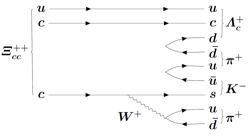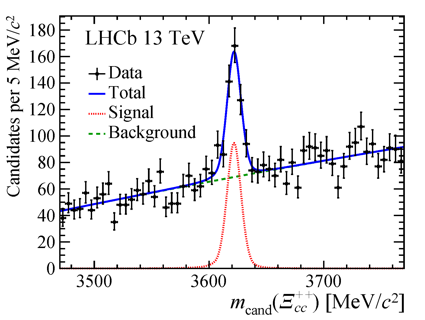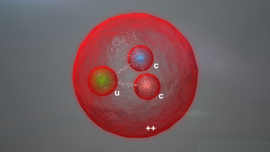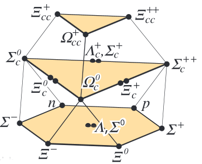[ m(Ξcc++) = 3621.40±0.72±0.27±0.14 MeV/c2 ]
Today, at the EPS Conference on High Energy Physics, EPS-HEP 2017, in Venice, Italy, the LHCb collaboration presented the first observation of a doubly charmed particle. This particle, called the Ξcc++, is a baryon (particle composed of three quarks) containing two charm quarks and one up quark, resulting in an overall doubly positive charge. It is a doubly charm counterpart of the well-known lower mass Ξ0 baryon, which is composed of two strange quarks and an up quark.
The Ξcc++ baryon is identified via its decay into a Λc+ baryon and three lighter mesons K–, π+ and π+. The image above shows an example of a Feynman diagram contributing to this decay. The Λc+ baryon decays in turn into a proton p, a K– and a π+ meson. The image shows the Λc+K–π+π+ invariant mass spectrum obtained with 1.7 fb-1 of data collected by LHCb in 2016 at the LHC centre-of-mass energy of 13 TeV. The mass is measured to be about 3621 MeV/c2 which is almost four times heavier than the most familiar baryon, the proton, a property that arises from its doubly charmed-quark content. The signal candidates are consistent with particles that traveled a significant distance before decaying: even selecting only those Ξcc++ particles that survived more than approximately five times the expected decay time resolution, the signal remains highly significant. This state is therefore incompatible with a strongly decaying particle, but is consistent with a longer-lived decay involving weak interactions as would be expected for this particle.
The existence of doubly charmed baryons was already known to be a possibility in the 1970s, after the discovery of the charm quark. In the early 2000s the observation of a similar particle was reported by the SELEX collaboration. This observation was not confirmed by subsequent experiments and the measured properties of this particle are not compatible with those of the Ξcc++ baryon discovered by LHCb. The discovery of the Ξcc++ performed by LHCb has been made possible by the high production rate of heavy quarks at the LHC and thanks to the unique capabilities of the experiment, which can identify the decay products with excellent efficiency and purity. The image shows an artist view of this new particle. This animation shows how the signal accumulated in the Λc+K–π+π+ invariant-mass spectrum throughout 2016.
This discovery opens a new field of particle physics research. An entire family of doubly charmed baryons related to the Ξcc++ is predicted, and will be searched for with added enthusiasm. The image illustrates how half-spin baryons can be formed by assembling together the three light quarks (u, d, s) and the charm quark (Particle Data Group, Phys.Rev. D86, 010001). Furthermore, other hadrons containing different configurations of two heavy quarks, for example two beauty quarks or a beauty and charm quark, are waiting to be discovered. Measurements of the properties of all these particles will allow for precise tests of QCD, the theory of strong interactions, in a unique environment. LHCb is very well equipped to face this very exciting challenge.
Click images for higher resolution. More information can be found in the LHCb EPS-HEP presentation, in the LHCb publication and soon in the CERN seminar. Read also the CERN Press Release in English and French as well as the CERN Courier article.




